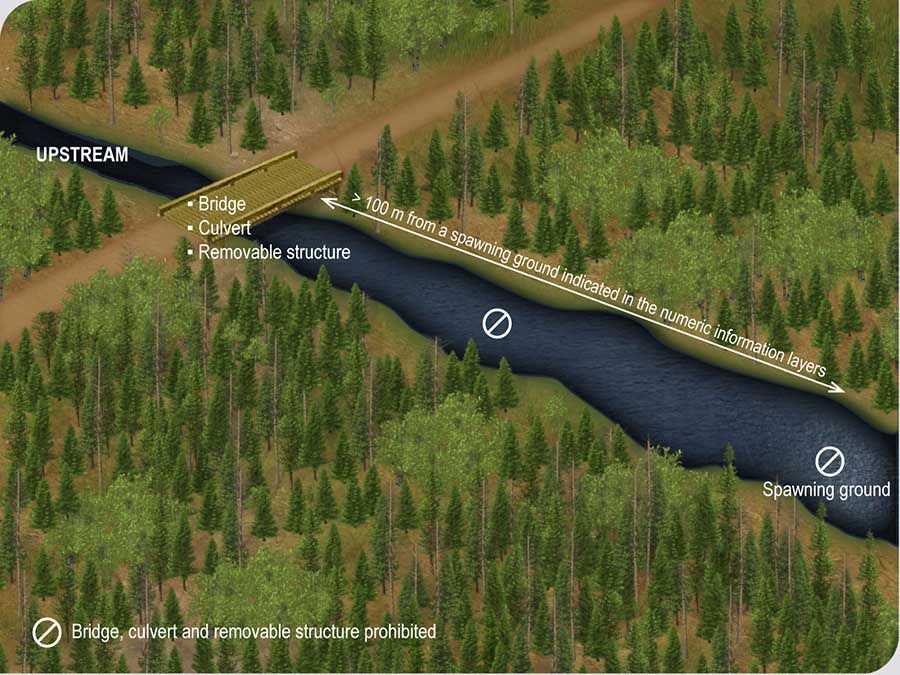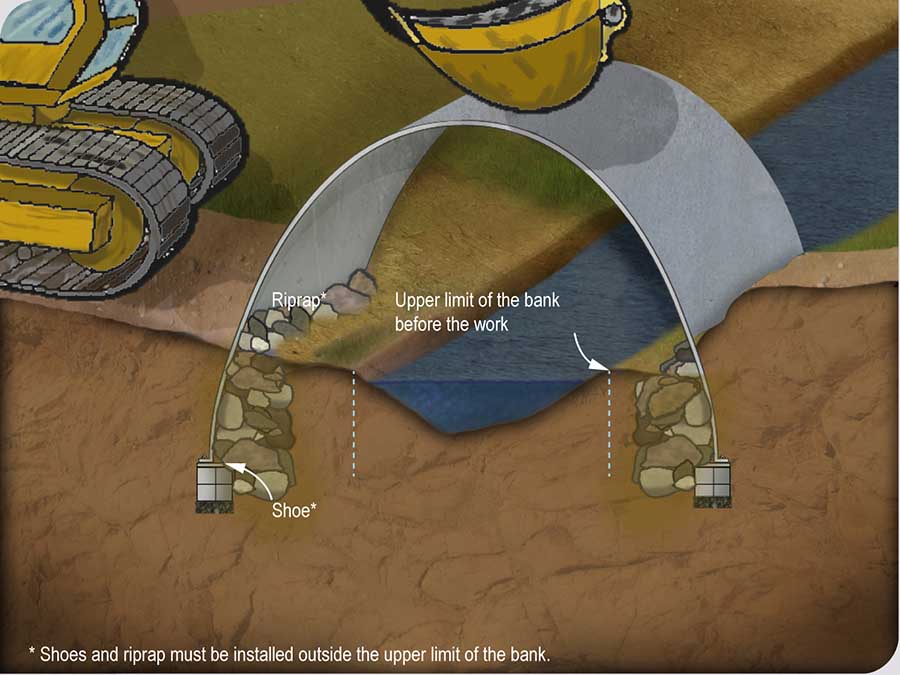Training – Quiz 5 Part 2
Chapter V – Part 2 – Bridges, culverts, removable structures and rudimentary structures
Question 1 Sections 88 and 89.
The construction of a bridge or culvert is prohibited on or in:
a) A winter road
b) A felling or hauling trail
c) A spawning ground
Select one of the following answers:
Right answer
Wrong answer
Question 2 Section 89.
a) The construction of a bridge or a culvert or the installation of a removable structure is prohibited in a spawning ground and in the first 50 metres upstream from a spawning ground indicated in the numeric information layers used for forest planning.
b) The construction of a bridge or a culvert or the installation of a removable structure is prohibited in a spawning ground and in the first 100 metres upstream from a spawning ground indicated in the numeric information layers used for forest planning.
c) The construction of a bridge or a culvert or the installation of a removable structure is prohibited in a spawning ground and in the first 250 metres upstream from a spawning ground indicated in the numeric information layers used for forest planning.
Which of the above statements is true?

Right answer
Wrong answer
Question 3 Section 90.
Techniques to limit the carrying of sediments the during construction, improvement or repair of a bridge or a culvert or the installation of a removable structure must be used at all times in a salmonid watercourse. These techniques include the drying of the work area, the performance of the work during the period of minimum flow and the installation of a sediment confinement curtain.
True or false?
Right answer
Wrong answer
Question 4 Section 92.
In the Mauricie administrative region (04), when construction, improvement or repair work is carried out on a bridge or culvert between the banks of a watercourse used by lake trout, and the work takes more than 72 consecutive hours, it must be carried out during a specific period of the year.
What is that period?
Right answer
Wrong answer
Question 5 Section 93.
When coffer dams or structures for the temporary diversion of a watercourse are installed, for how many days are these structures allowed to prevent the free flow of fish?
Right answer
Wrong answer
Question 6 Section 94.
What is the size of the fine particles that must not enter the coffer dams installed in salmonid watercourses?
Right answer
Wrong answer
Question 7 Section 97.
Every person carrying out a forest development activity that regularly uses a road crossing a watercourse must ensure that the bed of the watercourse is stabilized at the entrance and exit of the culvert.
True or false?
Right answer
Wrong answer
Question 8 Section 99.
The construction, improvement or repair of a bridge or culvert must be carried out in a manner that ensures its stability and operation regardless of the period during which the work is carried out and the methods used. The bridge or culvert must be stabilized as the work progresses and any defect must be corrected as soon as it is detected.
True or false?
Right answer
Wrong answer
Question 9 Section 101.
A peak flow calculation must be performed every time a bridge or culvert is constructed, improved or repaired.
True or false?
Right answer
Wrong answer
Question 10 Section 102.
A culvert with parallel conduits may have two conduits of different diameters.
True or false?
Right answer
Wrong answer
Question 11 Section 103.
During the construction, improvement or repair of a road that crosses a watercourse, the culvert must be installed so as to ensure the free flow of fish in all cases.
True or false?
Right answer
Wrong answer
Question 12 Section 104.
A smooth wall culvert with one conduit may be installed in a watercourse where the free flow of fish need not be ensured due to the presence of one of the situations described in section 103.
True or false?
Right answer
Wrong answer
Question 13 Section 105.
On crossing sites where the free flow of fish must be ensured, the depth at which the circular conduit of the culvert must be buried is calculated using a variety of parameters such as the slope of the watercourse, the length of the conduit, the diameter of the conduit, and so on. The burial depth must be 20% or 30% of the diameter of the conduit and must meet the maximum and minimum specifications set out in Schedule 9.
True or false?
Right answer
Wrong answer
Question 14 Sections 106, 107 and 108.
Where the free flow of fish must be ensured but the standards set out in section 105 cannot be met, the following structures may be installed:
a) A culvert including a conduit with outlets, designed and installed according to the conditions provided for in Schedule 10
b) A bridge or culvert with an arch or a bridge that satisfies other conditions, the installation of which has been authorized by the Minister under section 41 of the Sustainable Forest Development Act (chapter A-18.1) or the installation of which is authorized under a forestry permit or an agreement or contract entered into under the Act
c) A bridge or culvert with an arch, on the conditions specified in section 108
Select one of the following answers:
Right answer
Wrong answer
Question 15 Section 108.
The construction, improvement or repair of a bridge or culvert with an arch must not have the effect of:
Right answer
Wrong answer
Question 16 Section 108.
The shoes or walls of an arch must be installed outside:

Right answer
Wrong answer
Question 17 Section 110.
The installation of a removable structure is allowed exclusively in a felling or hauling trail, on a winter road and on a road that is intended to be used and closed permanently less than three years after its construction.
True or false?
Right answer
Wrong answer
Question 18 Section 113.
The installation of rudimentary or light structures to cross a watercourse, such as foot bridges or small structures made of logs, is only allowed in a trail that is not intended for motorized all-terrain vehicles, in particular in a cross-country ski trail, a bike trail and a hiking trail.
True or false?
Right answer
Wrong answer
Quiz 5 Part 2
You did not provide the correct answer to one or more of the questions.
If you wish to start over the quiz, click on the "start over" button.
Completed!
